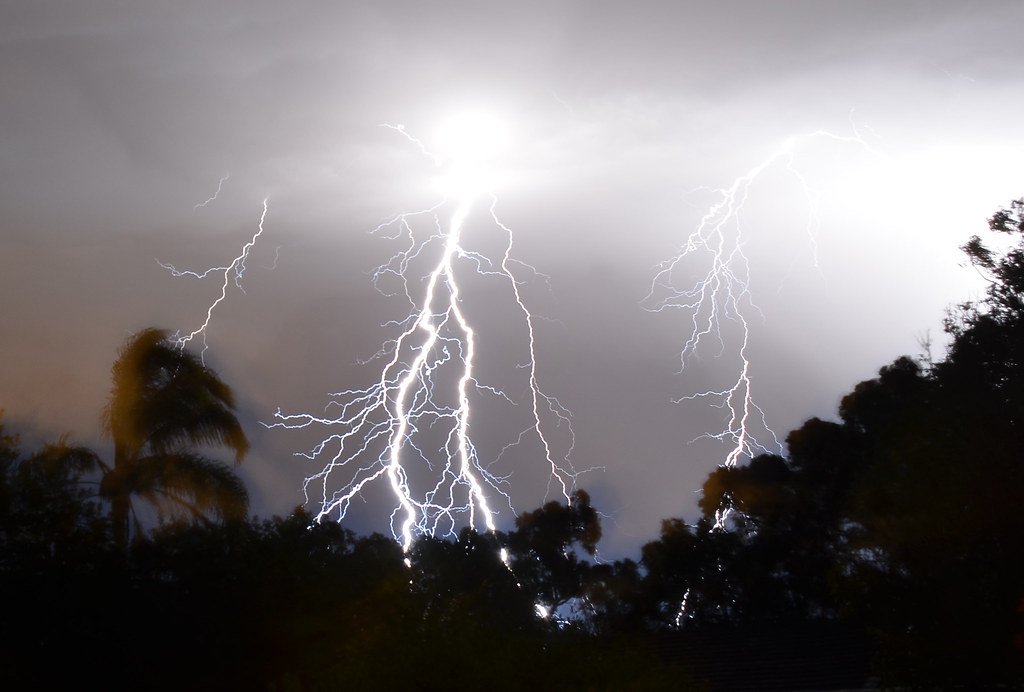We’ve all been there. Standing in a museum, watching a nature documentary, or scrolling through social media when someone drops what sounds like fascinating nature knowledge. Lightning never strikes twice in the same place! Sharks can smell blood from miles away! We nod knowingly, filing these “facts” away in our mental nature encyclopedia. But here’s the thing that might shake your understanding of the natural world – many of these widely accepted truths are actually myths that have been passed down through generations like an elaborate game of scientific telephone.
The Great Lightning Myth That Fooled Everyone

You’ve probably heard it countless times: lightning never strikes the same place twice. This myth has become so embedded in our collective consciousness that we use it as a metaphor for rare, once-in-a-lifetime events. But the reality is far more electrifying than the fiction.
Lightning actually loves to strike the same spots repeatedly, especially tall structures like buildings, trees, and radio towers. The Empire State Building gets struck by lightning about 25 times per year, and some particularly unlucky trees have been hit dozens of times throughout their lifespans. The myth likely persists because most people don’t witness lightning strikes in the same location multiple times – but that’s simply because we’re not constantly watching the sky during storms.
The science behind this is actually quite logical. Lightning follows the path of least resistance to the ground, and if a particular location provided that path once, it’s likely to do so again under similar conditions. Meteorologists have documented countless instances of lightning striking the same building, tree, or even person multiple times during a single storm.
Why This Myth Became So Popular

The “lightning never strikes twice” saying gained traction because it served as a comforting metaphor for overcoming adversity. People wanted to believe that if they survived one terrible experience, they wouldn’t have to face another similar one. This psychological comfort helped the myth spread faster than actual scientific knowledge.
Additionally, before modern weather tracking and photography, it was nearly impossible for people to document repeat lightning strikes. The brief, bright flash happens so quickly that without slow-motion cameras and scientific instruments, most people simply couldn’t observe the phenomenon accurately enough to debunk the myth.
Television weather reports and casual conversations continued to perpetuate this misconception, turning what should have been a simple observation about electrical discharge into one of nature’s most persistent myths.
The Truth About Sharks and Their Legendary Sense of Smell

Movies like “Jaws” and countless documentaries have painted sharks as bloodthirsty predators who can detect a single drop of blood from miles away. This dramatic claim has terrified beachgoers and fascinated marine biology enthusiasts for decades. However, the reality of shark sensory abilities is both more nuanced and less sensational than popular culture suggests.
Sharks do have an incredibly sensitive sense of smell – that part is true. They can detect blood in concentrations as low as one part per billion, which is roughly equivalent to detecting a teaspoon of blood in a swimming pool. But the idea that they can smell blood from miles away is a massive exaggeration that ignores how scent travels through water.
In reality, sharks typically need to be within a few hundred feet of a blood source to detect it, and the scent must be carried by ocean currents in their direction. Water doesn’t carry scent molecules the same way air does, and factors like water temperature, salinity, and current strength all affect how far and how quickly scent travels underwater.
How Ocean Currents Actually Carry Scent

Understanding how scent moves through water reveals why the “miles away” claim falls apart under scientific scrutiny. Unlike air, where scent molecules can spread in all directions relatively quickly, underwater scent dispersal depends heavily on water movement and density layers.
Ocean currents act like invisible highways for scent molecules, but these highways don’t go everywhere. A shark positioned upstream from a blood source might never detect it, while another shark downstream could pick up the scent relatively quickly. The three-dimensional nature of ocean currents means that scent can travel horizontally at one depth while being completely absent at another depth just a few feet away.
Marine biologists have conducted numerous studies tracking scent dispersal in water, and the results consistently show that effective scent detection range for sharks is measured in hundreds of feet, not miles. This doesn’t make sharks any less impressive as predators – it just makes their hunting abilities more realistic and scientifically accurate.
The Goldfish Memory Myth That Won’t Die

Perhaps no animal has been more unfairly maligned than the humble goldfish. The persistent belief that goldfish have three-second memories has become shorthand for forgetfulness and has even influenced how we design aquariums and treat pet fish. This myth is not only wrong but also surprisingly harmful to fish welfare.
Scientific studies have demonstrated that goldfish can remember things for months, not seconds. Researchers have trained goldfish to navigate mazes, recognize different people, and even respond to various colors and shapes. Some goldfish have shown the ability to remember feeding times and locations for weeks or even months.
The three-second memory myth likely originated from the pet industry as a way to justify keeping goldfish in tiny bowls without enrichment. If fish couldn’t remember anything, then providing them with interesting environments or social interaction seemed unnecessary. Unfortunately, this misconception has led to countless goldfish living in inadequate conditions that would be considered cruel for any other pet.
What Science Reveals About Fish Intelligence

Modern research has revolutionized our understanding of fish cognition, revealing that many species demonstrate complex behaviors that require significant memory and learning abilities. Goldfish can be trained to play soccer, distinguish between different musical pieces, and even perform simple mathematical operations.
Studies using controlled environments have shown that goldfish can form long-term memories and demonstrate what researchers call “episodic-like memory” – the ability to remember specific events and their contexts. Some goldfish have been observed remembering the locations of food sources for several months after being relocated to different tanks.
The implications of this research extend beyond just goldfish. Many fish species previously dismissed as simple creatures have shown remarkable cognitive abilities, suggesting that our understanding of animal intelligence has been severely limited by human bias and inadequate research methods.
The Great Wall of China Space Visibility Hoax

One of the most persistent myths about human achievement claims that the Great Wall of China is the only man-made structure visible from space. This “fact” has appeared in textbooks, documentaries, and countless conversations about human engineering marvels. It’s a claim that sounds plausible and feeds our desire to believe in extraordinary human accomplishments.
However, astronauts have repeatedly debunked this myth from their unique vantage point. The Great Wall of China is actually extremely difficult to see from space without magnification, and it’s certainly not visible from the moon as some versions of the myth claim. The wall’s narrow width and earth-toned materials make it blend into the surrounding landscape when viewed from orbit.
What’s more ironic is that many other human-made structures are much more visible from space than the Great Wall. City lights, major highways, large buildings, and even some parking lots show up more clearly in photographs taken from the International Space Station. The myth persists partly because it sounds impressive and partly because few people have the opportunity to personally verify it from space.
What Astronauts Actually See From Space

Real astronauts have provided fascinating insights into what human-made structures are actually visible from orbit. Large cities appear as sprawling bright patches at night, major rivers and coastlines create obvious boundaries, and agricultural patterns form geometric shapes across the landscape.
Surprisingly, some of the most visible human-made features from space are relatively modern creations. Large airport runways, massive shopping centers, and even some sports stadiums show up more clearly than ancient architectural marvels. The key factors for space visibility are size, contrast with surrounding terrain, and reflective properties – not historical significance or engineering complexity.
Astronauts have also noted that atmospheric conditions, lighting, and the specific orbit of their spacecraft dramatically affect what they can see. Something visible during one pass might be completely invisible during another, making the idea of any single structure being consistently visible from space even more questionable.
The Alpha Wolf Leadership Myth

The concept of the “alpha wolf” leading a pack through dominance and aggression has become deeply embedded in popular culture and even influenced human leadership theories. This idea suggests that wolf packs are hierarchical societies where the strongest, most aggressive wolf rises to the top and maintains control through intimidation and violence.
However, this understanding of wolf behavior is based on outdated research conducted on captive wolves in artificial environments. Modern wildlife biologists who study wolves in their natural habitats have discovered that wolf packs are actually family units, typically consisting of two parents and their offspring of various ages.
The so-called “alpha” wolves are simply the parents, and their leadership role comes from their status as the breeding pair and experienced adults, not from defeating other wolves in combat. Young wolves naturally follow their parents’ lead, just as human children follow their parents, and when they reach maturity, they typically leave to start their own families rather than challenging for pack leadership.
How Wolf Pack Dynamics Really Work

Understanding real wolf pack behavior reveals a much more cooperative and family-oriented structure than the aggressive hierarchy portrayed in popular media. Adult wolves work together to hunt, raise young, and defend territory, with roles based more on experience and age than on dominance battles.
The breeding pair (often called the “alpha” pair) makes decisions about when to hunt, where to travel, and how to respond to threats, but this leadership is based on their experience and parental responsibility rather than aggressive dominance. Other pack members contribute according to their abilities and age, creating a cooperative rather than competitive environment.
This family-based structure explains why wolf packs are typically small, ranging from 2 to 8 individuals, and why they don’t engage in the constant dominance battles that the alpha myth suggests. The cooperative model is actually much more efficient for survival and has been shaped by millions of years of evolution.
Why These Myths Persist in Popular Culture

The persistence of these nature myths reveals something fascinating about human psychology and our relationship with the natural world. We’re drawn to stories that are dramatic, memorable, and easily understood, even when they’re not scientifically accurate. These myths often fill emotional or psychological needs that pure facts cannot satisfy.
The alpha wolf myth, for example, appeals to our desire to understand leadership and social hierarchy in simple terms. The idea that strength and aggression determine leadership feels intuitive to many people, even though it doesn’t reflect how most successful groups actually function in nature or human society.
Media representation plays a huge role in perpetuating these myths. Movies, television shows, and even educational programs often prioritize dramatic storytelling over scientific accuracy, choosing the more exciting myth over the more complex reality. Once these ideas enter popular culture, they become incredibly difficult to dislodge.
The Role of Social Media in Spreading Misinformation

In our digital age, nature myths spread faster than ever before through social media platforms where dramatic claims get more engagement than nuanced scientific explanations. A post claiming that sharks can smell blood from miles away is more likely to be shared than one explaining the complex factors that affect underwater scent dispersal.
The format of social media also favors simple, memorable statements over detailed explanations. Complex scientific concepts get compressed into bite-sized “facts” that lose their context and nuance, making it easier for myths to proliferate while accurate information gets lost in the noise.
Additionally, the echo chamber effect of social media means that once someone believes and shares a nature myth, they’re likely to encounter it repeatedly in their feeds, reinforcing the false belief and making it seem more credible through repetition.
How Scientists Are Fighting Back Against Nature Myths

The scientific community has become increasingly aware of the need to actively combat widespread nature myths rather than simply ignoring them. Many researchers now engage directly with the public through social media, podcasts, and popular science writing to provide accurate information in accessible formats.
Museums and educational institutions have begun creating exhibits and programs specifically designed to debunk common nature myths while explaining the real science behind natural phenomena. These efforts recognize that simply presenting facts isn’t enough – myths must be directly addressed and replaced with compelling, accurate alternatives.
Citizen science projects have also emerged as powerful tools for combating misinformation. When people participate in real scientific research, they develop a deeper understanding of how the natural world actually works and become more skeptical of dramatic claims that don’t match their observations.
The Importance of Scientific Literacy in Nature Education

Teaching people how to evaluate scientific claims is becoming just as important as teaching specific facts about nature. Scientific literacy involves understanding how research is conducted, how evidence is evaluated, and how to distinguish between reliable and unreliable sources of information.
Nature education programs are increasingly emphasizing critical thinking skills alongside traditional wildlife knowledge. Students learn to ask questions like: What evidence supports this claim? Who conducted the research? Have the findings been replicated? These skills help people navigate the flood of information about nature and distinguish between facts and myths.
The goal isn’t to make everyone a scientist, but to help people become informed consumers of scientific information who can recognize when a claim about nature sounds too dramatic or simplistic to be true.
Why Getting Nature Facts Right Actually Matters

It might seem harmless to believe that lightning never strikes twice or that goldfish have three-second memories, but these myths can have real consequences for how we interact with and protect the natural world. Misconceptions about animal behavior can lead to poor conservation decisions, inappropriate pet care, and missed opportunities to appreciate the true complexity of nature.
When we understand that wolves are family-oriented rather than aggressively hierarchical, we can make better decisions about wildlife management and conservation. When we recognize that goldfish have complex memory and learning abilities, we can provide better care for pet fish and develop more humane research practices.
Perhaps most importantly, correcting these myths helps us develop a more accurate and nuanced appreciation for the natural world. Reality is often more fascinating than fiction, and understanding how nature really works can deepen our sense of wonder and connection to the environment around us.
Moving Forward: Embracing Scientific Curiosity

The journey from myth to understanding requires embracing curiosity and being willing to question what we think we know. The natural world is full of genuine mysteries and amazing phenomena that are far more interesting than the oversimplified myths that have captured our imagination.
Instead of clinging to dramatic but false beliefs, we can cultivate a sense of wonder about the real complexities of nature. The actual mechanisms behind lightning, the true cognitive abilities of fish, and the cooperative dynamics of wolf families are all more fascinating than their mythological counterparts.
This shift in perspective doesn’t diminish our appreciation for nature – it enhances it. When we understand the real science behind natural phenomena, we can appreciate the intricate web of factors that shape the living world and our place within it.
Conclusion: The Beauty of Scientific Truth

These five persistent myths about nature reveal how easily dramatic stories can overshadow scientific reality, but they also demonstrate the power of careful observation and research to reveal the truth. The real behaviors of sharks, wolves, goldfish, and even lightning are far more nuanced and fascinating than the simplified versions that have captured popular imagination.
As we move forward in an age of rapid information sharing, developing the skills to distinguish between compelling myths and scientific facts becomes increasingly important. The natural world deserves our accurate understanding, not our comfortable misconceptions.
The next time someone shares a dramatic “fact” about nature, remember that the most amazing truths about the natural world are often the ones that have been carefully studied and verified by scientists. Reality has a way of being more wonderful than fiction, if we’re willing to look closely enough to see it.
What other “facts” about nature have you accepted without question?



